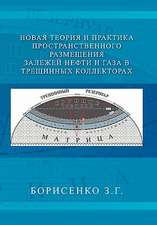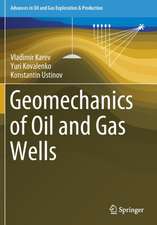Handbook of Mathematical Geosciences: Fifty Years of IAMG
Editat de B.S. Daya Sagar, Qiuming Cheng, Frits Agterbergen Limba Engleză Hardback – 16 iul 2018
This Open Access handbook published at the IAMG's 50th anniversary, presents a compilation of invited path-breaking research contributions by award-winning geoscientists who have been instrumental in shaping the IAMG. It contains 45 chapters that are categorized broadly into five parts (i) theory, (ii) general applications, (iii) exploration and resource estimation, (iv) reviews, and (v) reminiscences covering related topics like mathematical geosciences, mathematical morphology, geostatistics, fractals and multifractals, spatial statistics, multipoint geostatistics, compositional data analysis, informatics, geocomputation, numerical methods, and chaos theory in the geosciences.
| Toate formatele și edițiile | Preț | Express |
|---|---|---|
| Paperback (1) | 434.98 lei 38-44 zile | |
| Springer International Publishing – 30 ian 2019 | 434.98 lei 38-44 zile | |
| Hardback (1) | 475.82 lei 3-5 săpt. | |
| Springer International Publishing – 16 iul 2018 | 475.82 lei 3-5 săpt. |
Preț: 475.82 lei
Nou
Puncte Express: 714
Preț estimativ în valută:
91.05€ • 95.06$ • 75.35£
91.05€ • 95.06$ • 75.35£
Carte disponibilă
Livrare economică 15-29 martie
Preluare comenzi: 021 569.72.76
Specificații
ISBN-13: 9783319789989
ISBN-10: 3319789988
Pagini: 875
Ilustrații: XXVIII, 914 p. 287 illus., 185 illus. in color. With online files/update.
Dimensiuni: 155 x 235 x 46 mm
Greutate: 1.7 kg
Ediția:1st ed. 2018
Editura: Springer International Publishing
Colecția Springer
Locul publicării:Cham, Switzerland
ISBN-10: 3319789988
Pagini: 875
Ilustrații: XXVIII, 914 p. 287 illus., 185 illus. in color. With online files/update.
Dimensiuni: 155 x 235 x 46 mm
Greutate: 1.7 kg
Ediția:1st ed. 2018
Editura: Springer International Publishing
Colecția Springer
Locul publicării:Cham, Switzerland
Cuprins
1. Forward.- 2. Preface.- 3. Introduction.- 4. Part I. Chapter 1 Kriging, Splines, Conditional Simulation, Bayesian In-version and Ensemble Kalman Filtering.- 5. Chapter 2 A Statistical Commentary on Mineral Prospectivity analysis.- 6. Chapter 3 Testing joint conditional independence of categorical random variables with a standard log-likelihood ratio test.- 7. Chapter 4 Modelling Compositional Data. The Sample Space Approach.- 8. Chapter 5 Properties of Sums of Geological Random Variables.- 9. Chapter 6 A Statistical Analysis of the Jacobian in Retrievals of Satellite Data.- 10. Chapter 7 All Realizations All the Time.- 11. Chapter 8 Binary Coefficients Redux.- 12. Chapter 9 Tracking Plurigaussian Simulations.- 13. Chapter 10 Mathematical Geosciences: Local Singularity Analysis of Nonlinear Earth Processes and Extreme Geo-Events.- 14. Chapter 11 Electrofacies in Reservoir Characterization.- 15. Chapter 12 Forecast of Shoreline Variations by Means of Median Sets.- 16. Chapter 13 An Introduction to the Spatio-Temporal Analysis of Sat-ellite Remote Sensing Data for Geostatisticians.- 17. Chapter 14 Flint drinking water crisis: a first attempt to model geo-statistically the space-time distribution of water lead levels.- 18. Chapter 15 Statistical Parametric Mapping for Geoscience Applications.- 19. Chapter 16 Water chemistry: are new challenges possible from CoDA (Compositional Data Analysis) point of view?.- 20. Chapter 17 Analysis of the United States Portion of the North American Soil Geochemical Landscapes Project – A Compositional Framework Approach.- 21. Chapter 18 Quantifying the Impacts of Uncertainty.- 22. Chapter 19. Advances in Sensitivity Analysis of Uncertainty due to Sampling Density for Spatially Correlated Attributes.- 23. Chapter 20 Predicting Molybdenum Deposit Growth.- 24. Chapter 21 General Framework of Quantitative Target Selections.- 25. Chapter 22 Solving the Wrong Resource Assessment Problems Precisely.- 26. Chapter 23 two ideas for analysis of multivariate geochemical survey data: proximity regression and principal component residuals.- 27. Chapter 24 Mathematical minerals: A history of petrophysical petrography.- 28. Chapter 25 Geostatistics for Seismic Characterization of Oil Reservoirs.- 29. Chapter 26 Statistical Modeling of Regional and Worldwide Size-Frequency Distributions of Metal Deposits.- 30. Chapter 27 Bayesianism in the Geosciences.- 31.Chapter 28 Geological Objects and Physical Parameter Fields in the Subsurface: A Review.- 32.Chapter 29 Fifty Years of Kriging.- 33. Chapter 30 Multiple Point Statistics: A Review.- 34. Chapter 31 When Should We Use Multiple-Point Geostatistics?.- 35. Chapter 32 The Origins of the Multiple-Point Statistics (MPS) Algorithm.- 36. Chapter 33 Predictive Geometallurgy: An Interdisciplinary Key Challenge for Mathematical Geosciences?.- 37. Chapter 34 Data Science for Geoscience: Leveraging Mathematical Geosciences with Semantics and Open Data.- 38. Chapter 35 Mathematical Morphology in Geosciences and GISci: An Illustrative Review.- 39. Chapter 36 IAMG: Recollections from the Early Years.- 40. Chapter 37 Forward and Inverse Models over 70 Years.- 41. Chapter 38 From individual personal contacts 1962–1968 to my 50 years of service.- 42. Chapter 39 Andrey Borisovich Vistelius.- 43. Chapter 40 Fifty Years’ Experience with Hidden Errors in Applying Classic Mathematical Geology.- 44. Chapter 41 Mathematical Geology by Example: Teaching and Learning Perspectives.
Recenzii
“The book is an excellent resource for students, young scientists, practicing geologists, geophysicists, and geoscientists who want to better understand mathematical methods. … The handbook is a comprehensive reference that should have a place on the bookshelves of graduate students and researchers in the field of geosciences who are interested in using mathematical methods to analyze data.” (Yuriy Kostyuchenko, Mohamed Abioui and Andrea Di Cencio, Mathematical Geosciences, Vol. 52, 2020)
Notă biografică
B.S. Daya Sagar is a full Professor at the Systems Science and Informatics Unit (SSIU) at the Indian Statistical Institute in Bangalore, India. Dr. Sagar received his MSc and Ph.D. degrees in geoengineering and remote sensing from the Faculty of Engineering, Andhra University, Visakhapatnam, India, in 1991 and 1994 respectively. He is also first Head of the SSIU. Earlier, he worked at the College of Engineering, Andhra University, and Centre for Remote Imaging Sensing and Processing (CRISP), at the The National University of Singapore in various positions during 1992-2001. He served as Associate Professor and Researcher at the Faculty of Engineering & Technology (FET), Multimedia University, Malaysia, during 2001-2007. Since 2017, he has been a Visiting Professor at the University of Trento, Italy. His research interests include mathematical morphology, GISci, digital image processing, fractals and multifractals, their applications in extraction, analyses, and modelling of geophysical patterns. He has published over 85 papers in scientific journals, and has authored and/or guest edited 11 books and/or special theme issues for journals. He recently authored a book entitled "Mathematical Morphology in Geomorphology and GISci". He recently co-edited two special issues on "Filtering and Segmentation with Mathematical Morphology" for IEEE Journal of Selected Topics in Signal Processing and "Applied Earth Observation and Remote Sensing in India" for IEEE Journal of Selected Topics in Applied Earth Observation and Remote Sensing. He is an elected Fellow of Royal Geographical Society (1999), Indian Geophysical Union (2011), and was a member of the New York Academy of Science during 1995-1996. He received the Dr. Balakrishna Memorial Award from the Andhra Pradesh Academy of Sciences in 1995, the Krishnan Gold Medal from the Indian Geophysical Union in 2002, and the "Georges Matheron Award-2011 (with Lecturership)" of the International Association for Mathematical Geosciences. He is the Founding Chairman of Bangalore Section IEEE GRSS Chapter. He is on the Editorial Boards of Computers & Geosciences, and Frontiers: Environmental Informatics.
Qiuming Cheng did his Ph.D. in Earth Science under supervision of Dr. Frits Agterberg at the University of Ottawa in 1994. Dr. Cheng spent a year at the Geological Survey of Canada as a PDF under the supervision of Dr. Graeme Bonham-Carter, and soon became a faculty member at York University, Toronto, Canada in 1995 with cross appointments in the Department of Earth and Space Science and Engineering and the Department of Geography. He was promoted to associate professor in 1997 and to full professor in 2002. He was awarded a Changjiang Scholar Professorship in China by the China Ministry of Education where he has set up and leads the State Key Lab of Geological Processes and Mineral Resources (GPMR) located on both campuses of China University of Geosciences in Beijing and Wuhan. Currently, he holds a Thousand Talent National Special Professorship of China, serving as the founding director of the GPMR lab. Dr. Cheng has specialized in mathematical geosciences with a research focus on nonlinear mathematical modelling of earth processes and geoinformatics techniques for prediction of mineral resources. He has authored and coauthored more than 300 research articles. He has been awarded several prestigious awards including the Krumbein Medal, the highest award by the International Association for Mathematical Geosciences (IAMG). Dr. Cheng was an elected President of the International Association for Mathematical Geosciences (IAMG) during 2012-16. He is the president of International Union of Geological Sciences (IUGS) for the period between 2016 and 2020. Dr. Cheng is an international leader in the application of nonlinear mathematics and geoinformatics to the analysis, modelling and prediction of a wide range of geological processes and mineral resources quantitative assessment. Dr. Cheng’s primary research interest involves the interdisciplinary study of non-linear properties of the Earth’s systems, as well as quantitative assessment and prediction of natural resources and environmental impacts. His research on fractal density & local singularity analysis theory and geomathematical models has made a major impact in several geoscientific disciplines, including those concerned with ocean ridge heat flow, magmatic flare-up during continent crustal growth and formation of supercontinents, earthquakes, floods, hydrothermal mineralization, and prediction of deeply buried mineral deposits.
Textul de pe ultima copertă
This Open Access handbook published at the IAMG's 50th anniversary, presents a compilation of invited path-breaking research contributions by award-winning geoscientists who have been instrumental in shaping the IAMG. It contains 45 chapters that are categorized broadly into five parts (i) theory, (ii) general applications, (iii) exploration and resource estimation, (iv) reviews, and (v) reminiscences covering related topics like mathematical geosciences, mathematical morphology, geostatistics, fractals and multifractals, spatial statistics, multipoint geostatistics, compositional data analysis, informatics, geocomputation, numerical methods, and chaos theory in the geosciences.
Caracteristici
Presents a unique Open Access work consisting of a fusion of geology, hydrology, mining engineering, geoengineering, and applications of quantitative techniques and methodology in these fields Demonstrates past, present and future demands for mathematical geoscientists in academia and industry Gives a historical overview of IAMG's development over 50 years Offers contributions of award-winning mathematical geoscientists on applications of mathematics, statistics, computers, and informatics Contains path-breaking mathematical frameworks, approaches, methodologies and algorithms to deal with different problems frequently encountered by geoscientists over the last 50 years Explores past, present and future demands for mathematical geosciences in academic and industry professions
























